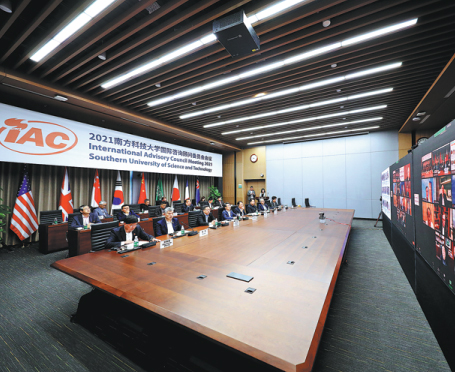SUSTech gathers global academics to discuss development
President Xue's outline of major projects focusing on fundamental science and key technology breakthroughs also impressed the IAC.The projects have earmarked substantial funds for 10 specific centers.
He also identified the development of Guangming Science City and the construction of cutting-edge research facilities, such as the free-electron laser, as crucial elements in attracting high-level talents to the city of Shenzhen.
Many IAC members gave considered suggestions on the positive opportunities SUSTech and Chinese universities can make use of to continue their rise.
Tony F. Chan, president of King Abdullah University of Science and Technology in Saudi Arabia, identified Shenzhen's advantages as a center of global innovation. He believes this is hugely beneficial in attracting talents, comparing SUSTech's situation to that of Stanford, where students often enroll at Silicon Valley due to the proximity. "We have students who come to Stanford. Stanford is a steppingstone to Silicon Valley… Then of course you have people who started Cisco, Google, HP and so on," he said.
Samuel L. Stanley Jr., president of Michigan State University and a prominent biomedical researcher, enquired about the progress in developments with the medical school since his previous visit to SUSTech in 2018. President Xue and his team then briefed the IAC on the major international project of SUSTech-KCL School of Medicine in partnership with King's College London, which got the green light from the Ministry of Education this November.

SUSTech leaders speak with 17 influential presidents and academic leaders from across the globe during the online 2021 meeting of the SUSTech International Advisory Council, which was held last week. CHINA DAILY
As the IAC looked to SUSTech's second decade, they identified further opportunities. David Richardson, vice-chancellor of the University of East Anglia in the United Kingdom, asked about the nature of the two new Shenzhen universities under development at SUSTech: Shenzhen Ocean University and Shenzhen Institute of Design and Innovation, and how SUSTech will continue to take advantage of such projects and its state-of-the-art facilities such as its cryo-electron microscopy center.
The council meeting also offered potential for stronger partnerships between SUSTech and IAC members' institutions moving forward in student exchanges, entrepreneurship education, joint research in specific fields, online programs and more.
Aside from the positive news of SUSTech's progress and the opportunities available, IAC members pinpointed several areas of risk and advised the university's senior leadership to be aware of each. The role of the ongoing pandemic in international mobility and exchange was one such area, and the effect of this on the challenging work in recruiting and retaining quality faculty and students, in particular international ones, was a highlighted concern.
Louise Richardson, vice-chancellor of the University of Oxford, emphasized the important role of the arts and humanities in science, technology, engineering and mathematics, or STEM, education. She said they can "underpin much of the work of the sciences if they are well integrated" and that it was her hope that SUSTech would continue to promote their integration into the undergraduate curriculum.
Caltech President Emeritus Chameau advised against the superficial division of fundamental research and applied science, and proposed that research institutions should "pay attention to quality over quantity" with regards to research output.
In his closing remarks, president Xue expressed his wholehearted wish that the next IAC meeting could take place on the SUSTech campus in Shenzhen. He hoped that future cooperation between SUSTech and its partner institutions may continue to be as fruitful as possible.



 Print
Print Mail
Mail

